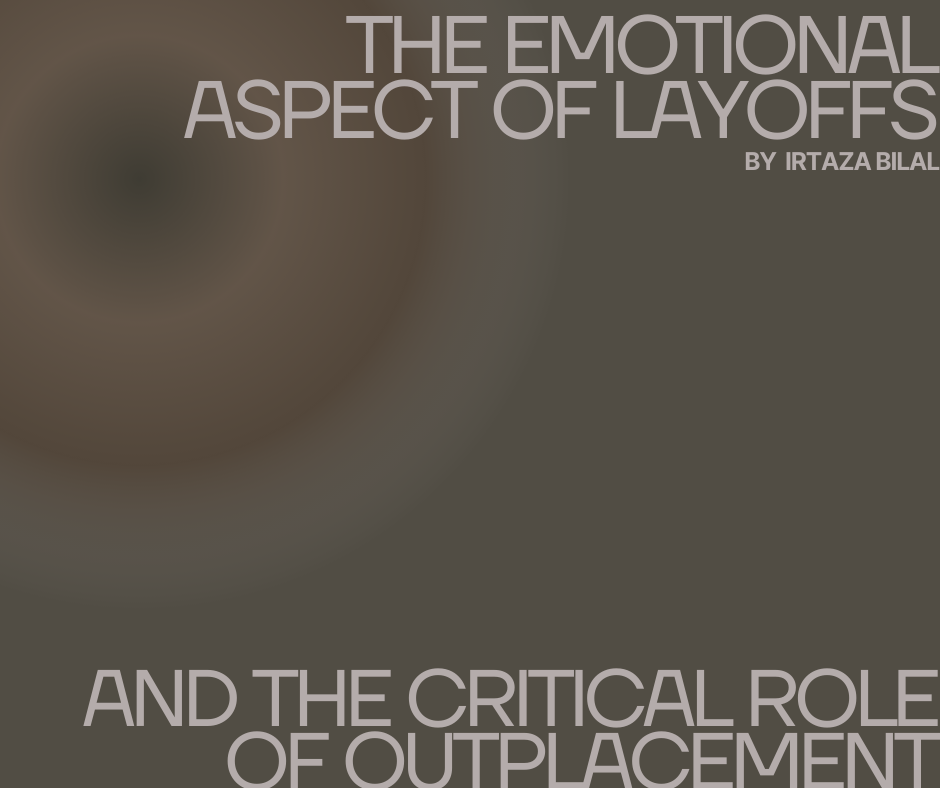When Jobs Are Lost, So Are Lives as People Know Them
Layoffs are more than just business decisions. They are life-altering moments for individuals and their families. In boardrooms, layoffs are often discussed as necessary cost-saving strategies, but in living rooms across the globe, they feel like earthquakes that shatter security, identity, and dignity.
Behind every layoff is a person—a father, a mother, a young dreamer, or a loyal contributor—who now faces not only the loss of income but the emotional trauma of feeling discarded, unseen, and devalued.
And yet, this devastating emotional impact is rarely addressed. It’s time to change that. It’s time for companies to act with urgency, empathy, and accountability—and that starts with understanding the true role of outplacement.
The Silent Pain: Understanding the Emotional Impact of Layoffs
Layoffs cut deeper than most realize. The effects go beyond financial insecurity:
Shock: Most employees don’t see it coming. One moment they are contributing, the next, they are told they’re no longer needed.
Shame and Guilt: Even if performance wasn’t the issue, people internalize layoffs as personal failure.
Anxiety and Uncertainty: “How will I pay my bills?” “Will I find a job soon?” “What do I tell my family?”
Loss of Identity: For many, their job is their identity. When it’s gone, so is a sense of purpose.
Depression and Isolation: Layoffs can lead to emotional withdrawal, declining mental health, and even long-term psychological trauma.
Ignoring these emotions is a leadership failure. It creates an environment where people become disposable, and trust erodes—not only among those laid off but among the survivors, too.
Why Outplacement Is No Longer a Luxury—It’s a Leadership Responsibility
Outplacement is often misunderstood. It’s not a “nice gesture.” It’s a strategic, humane, and ethical necessity. It shows that an organization doesn’t just fire people—it supports them through transition.
Outplacement offers:
Career Coaching: Personalized guidance to help individuals navigate their next steps.
Resume & LinkedIn Support: Helping individuals rebrand and present themselves with confidence.
Interview Preparation: Equipping candidates to face the job market head-on.
Mental Health Support: Offering counseling to manage the stress and anxiety of job loss.
Job Search Resources: Access to a network, job boards, and professional communities.
When outplacement is done right, it restores confidence, preserves dignity, and accelerates recovery. It also strengthens the employer brand and protects the organization’s reputation in a world that is watching more closely than ever.
Act Before It’s Too Late: The Urgency to Build Compassionate Exit Strategies
The emotional wounds of layoffs don’t heal automatically with time. Without a system in place, the impact lingers—for months, sometimes years.
If you’re a decision-maker, ask yourself:
What will your former employees say about your organization the day after they’re laid off?
Did you just end their job—or did you destroy their confidence?
Did you provide hope—or leave them in despair?
Your actions—or inactions—will define your company’s legacy.
Building a Responsible Future: What Every Company Must Do Now
1. Normalize Compassionate Communication
Don’t deliver the layoff like reading a script. Leaders must speak with empathy and clarity. People may forget your words but will never forget how you made them feel.
2. Implement a Structured Outplacement Program
Partner with outplacement services that offer practical and emotional support. The investment is small compared to the damage caused by negative word-of-mouth and broken morale.
3. Support the ‘Survivors’
Layoffs don’t just affect those who leave. The employees who remain behind often struggle with guilt, fear, and disillusionment. Open communication and support for them are equally crucial.
4. Humanize the Offboarding Process
Turn the exit into a transition, not a rejection. Let it be a bridge, not a wall. Respect should guide every step of that process.
5. Protect Your Employer Brand
The world is watching. In the age of social media and employee review platforms, how you treat exiting employees speaks louder than any marketing campaign.
Final Thoughts: Every Layoff Is a Moment to Lead with Heart
Layoffs may sometimes be inevitable—but heartlessness is not.
It’s easy to write severance letters. It takes courage to offer support, kindness, and outplacement services that say: We see you. We value what you gave. We believe in your future.
The companies that stand out in the future will not be the ones that cut fastest—but the ones that care deepest.
This is your opportunity to lead with humanity, responsibility, and foresight.
Because in the end, leadership is not about the decisions you make when everything is going right—
It’s about the compassion you show when everything is falling apart.
Act now. Build systems. Be human. Revolutionize the way we exit. Because people matter—always.

